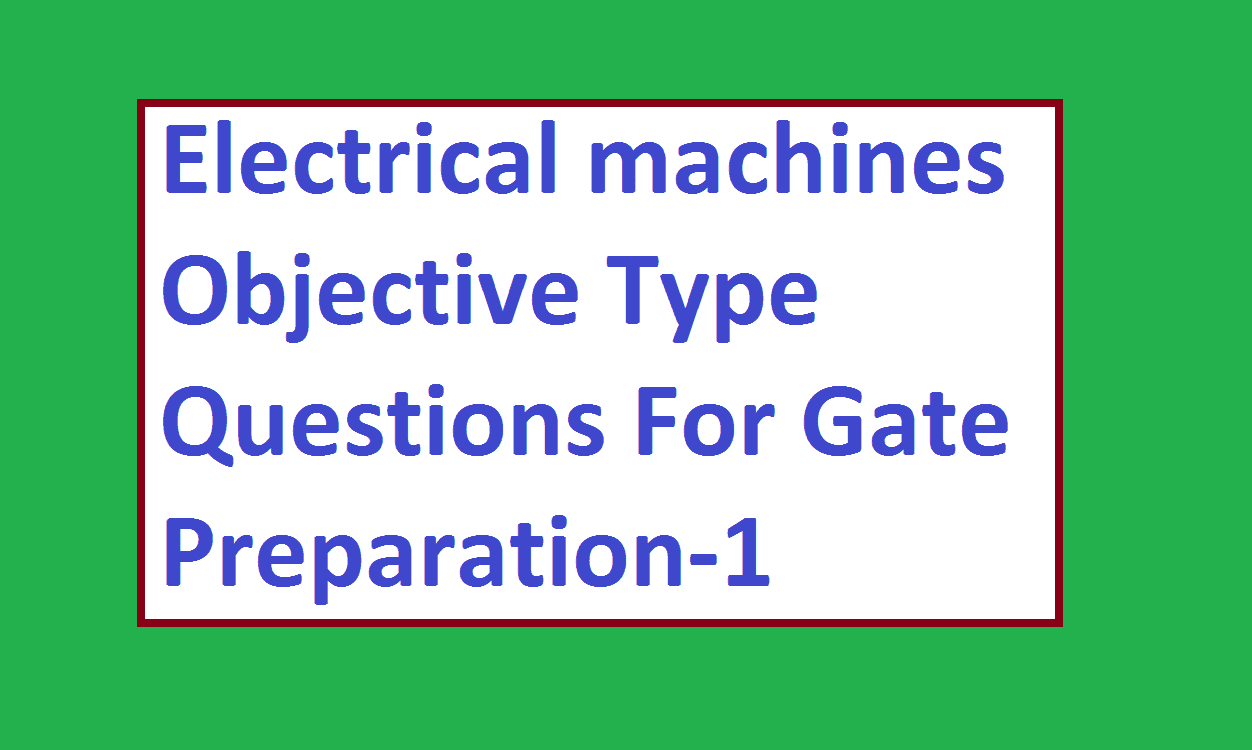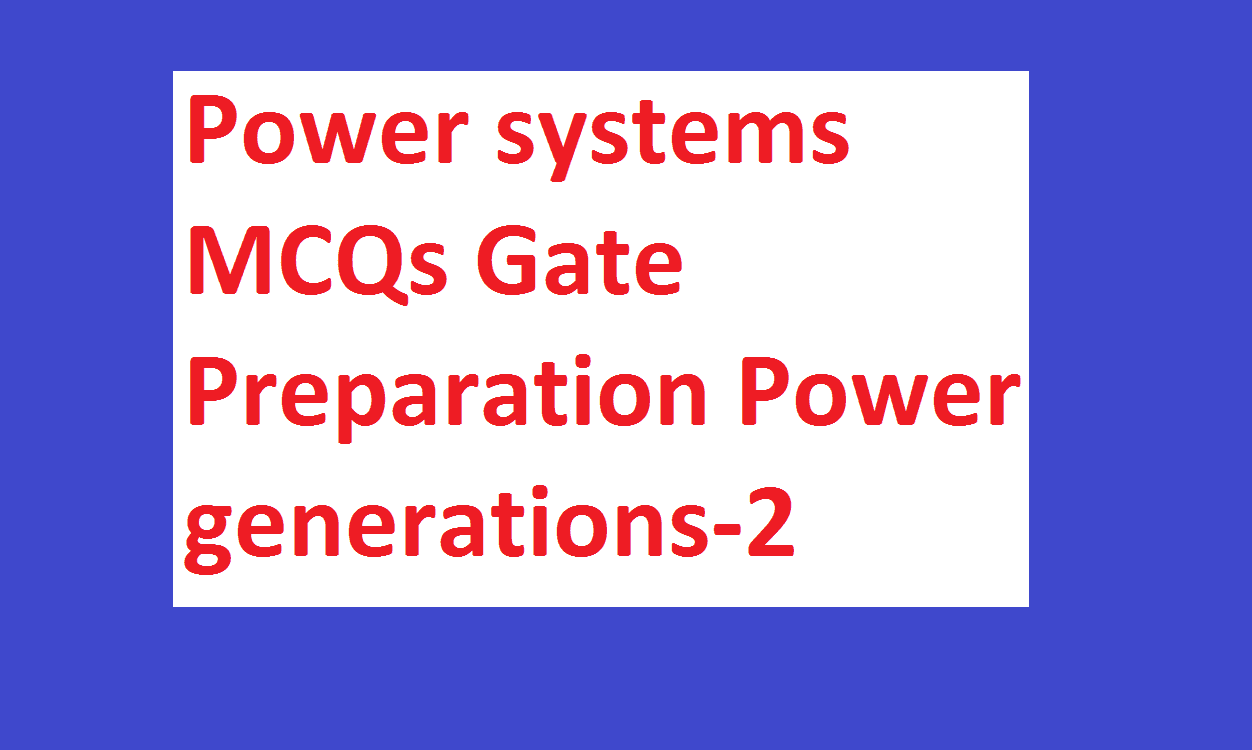Electrical machines Objective Type Questions For Gate Preparation-1
Transformer
1.A Single-phase transformer when supplied from 220V,50 Hz has eddy current loss of 50W.if the transformer is connected to a voltage of 330 V,50Hz, the eddy current loss will be
a)168.75W b)112.5W
c)75W d)50W
Answer: 112.5W
2.A coil wound on a magnetic core is excited from an ac voltage source. The source voltage and its frequency are both doubled. The eddy current loss in the core will become
a) half b) remains same
c)double d) four times
Answer: four times
3.Building steel core out of stampings reduces eddy current loss because it
a) increases core resistivity.
b) increases the effective length of eddy current paths thereby increasing effective resistance to the flow of eddy currents.
c)increases core permeability.
d)reduces the effective length of eddy current path thereby reducing effective resistance to the flow of eddy currents.
Answer: increasing the effective length of eddy current paths thereby increasing effective resistance to the flow of eddy currents.
4.A200/100 V, 50Hz, transformer is to be excited at 40Hz from the 100 V side. For the exciting current to remain the same, the applied voltage should be
a)150V b)125V
c)100V d)80V
Answer:80V
5.The applied voltage of a certain transformer is increased by 50% while the frequency is reduced to 50%.the maximum core flux density will
a) become three times b)become 1.5 times
c)become half d)remain the same
Answer: become three times
6.Which of the following tests must be performed on a transformer to determine its leakage reactance?
a) SC test only
b) OC test only
c)both OC and SC tests
d)test by an impedance bridge
Answer: both OC and SC tests
7.Power input to a transformer on no load at rated voltage comprises predominantly
a) copper loss b) hysteresis loss
c)core loss d) eddy current loss
Answer: core loss
[wp_ad_camp_1]
8.Hysteresis losses are directly proportional to the
a) square of frequency and flux density to the power 1.6.
b) frequency and proportional to the flux density to the power 1.6.
c)the square and frequency and proportional to the square of flux density.
d)frequency and proportional to flux density.
Answer: frequency and proportional to the flux density to the power 1.6
9.for fixed primary voltage hoe does the secondary terminal voltage of a transformer change if the pf of inductive load is raised from 0.7 to 0.9 with load current remaining fixed?
a) no change in voltage
b) voltage decreases
c)voltage rises
d)voltage will rise, go through a maximum and then decrease
Answer: voltage rises
10.For fixed primary voltage how does the secondary terminal voltage of a transformer change if the pf of capacitive load rises from 0.7 to 0.9 with load current remaining fixed
a) no change in voltage
b) voltage decreases
c)voltage rises
d)voltage decreases, goes through a minimum and then rises
Answer: voltage decreases
11.Transformer excited from a sinusoidal voltage source will draw a no-load current, which
a) is sinusoidal and of the same frequency as the voltage source.
b) comprises the fundamental frequency (same as that of the voltage source) and the peaking third harmonic.
c)comprises the fundamental frequency and the depressing third harmonic.
d)is sinusoidal of frequency three times that of the voltage source.
Answer: comprises the fundamental frequency (same as that voltage source) and the peaking third harmonic.
12.A transformer on no-load is switched on to a source of voltage.it will draw a current, which is
a) the same as the steady-state magnetizing current.
b) several times the steady-state magnetizing current depending upon the initial state of the residual flux in the transformer core.
c)several times the steady-state magnetizing current independent of the initial state of the residual flux in the transformer core.
d)twice the steady-state magnetizing current provided the core has no residual flux.
Answer: several times the steady-state magnetizing current depending upon the initial state of the residual flux in the transformer core.
13.A 2/1 ratio, two-winding transformer is connected as an auto transformer. Its kVA rating as an auto transformer compared to a two-winding transformer is
a) same b)1.5 times
c)2times d)3times
Answer:3times
14.On the two sides of a star/delta transformer
a) voltages and currents are both in phase
b) voltages and currents both differ in phase by 30degree
c)voltages differ in phase by 30degree but voltages are in phase
d)currents differ in phase by 30degree but voltages are in phase
Answer: voltages and currents both differ in phase by 30degree
15.the efficiency of a transformer at full-load 0.85 pf lag is 95%.its efficiency at full-load 0.85 pf lead will be
a) less than 95% b) more than 95%
c)95% d)100%
Answer:95%
16.the starter of a 415V, 50Hz,6-pole,970rpm,3-phase slip-ring induction motor is fed with normal voltage. The rotor with slip rings open-circuited is rotated at 500 rpm along the normal direction of its rotation. The frequency of the voltage across slip rings will be
a)1.5Hz b)25Hz
c)26.5Hz d)75Hz
Answer:25Hz
[wp_ad_camp_1]
Also see: Use of Transformer Vector Grouping
17.A 2500/250 V,25kVA transformer is connected as an auto transformer to give 2300/2750V.its rating would be
a)250kVA;225kVA is transformed conductively
b)250kVA;225kVA is transformed inductively
c)275kVA;250kVA is transformed inductively
d)275kVA;250kVA is transformed conductively
Answer:275kVA;250kVA is transformed conductively
18.A1 kVA,230 V/100V, single phase, 50 Hz transformer having negligible winding resistance and leakage inductance is operating under saturation, while 250V,50Hz sinusoidal supply is connected to the high voltage winding. A resistive load is connected to the low voltage winding which draws rated current. Which one of the following draws rated current? Which one of the following quantities will not be sinusoidal?
a) voltage induced across the low voltage winding
b) core flux
c)load current
d)current drawn from the source
Answer: current drawn from the source
19.The efficiency of a 100 kVA transform is 0.98 at full as well as at half load. For this transformer at full load the copper loss is
a) less than core loss b) equal to core loss
c)more than core loss d) none of these
Answer: more than core loss
20.The low voltage winding of a 400/230v, 1-phase, 50 Hz transformer is to be connected to a 25 Hz, the supply voltage should be
a)230V b)460V
c)115V d)65V
Answer:115V
21.Auto-transformer is used in transmission and distribution
a) when operator is not available
b) when iron losses are to be reduced
c)when efficiency considerations can be ignored
d)when the transformation ratio is small
Answer: when the transformation is small
22.Keeping in view the requirement of parallel operation, which of the 3-phase connections given below are possible?
a) delta-delta to delta-star
b) delta-delta to star-delta
c)star-star to delta-delta
d)delta-star to star-delta
Answer: star-star to delta-delta
23.Supply to one terminal of a delta-wye connection three-phase core type transformer which is on no-load, fails. Assuming magnetic circuit symmetry, voltages on the secondary side will be
a) 230,230,115 b) 230,115,115
c)345,115,115 d)345,0,345
Answer: 230,230,115
24.A220/440 V, 50 Hz, 5 kVA single phase transformer operates on 220 V, 40 Hz supply with secondary winding. Then
a) the eddy current loss and hysteresis loss of the transformer decrease
b) the eddy current loss and hysteresis loss of the transformer increase
c)the hysteresis loss of the transformer increases while eddy current loss remains the same
d)the hysteresis loss remains the same whereas eddy current loss decreases
Answer: the eddy current loss and hysteresis loss of the transformer decrease
25.A 3-phase delta/star transformer is supplied at 6000V on the delta-connected side. The terminal voltage on the secondary side when supplying full load at 0.8 lagging power-factor is 415 V. The equivalent resistance and reactance drops for the transformer are 1% and 5% respectively. The turns ratio of the transformer is
a)14 b)24
c)42 d)20
Answer:24






